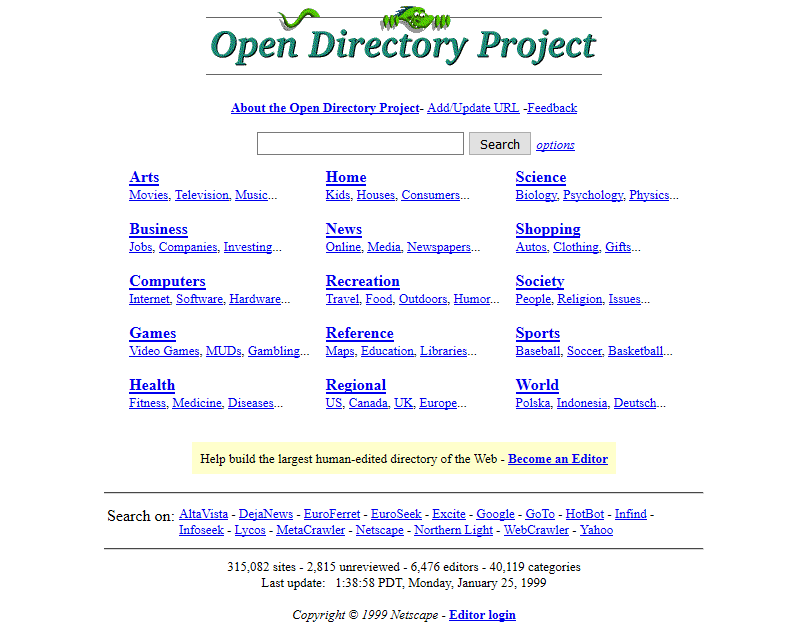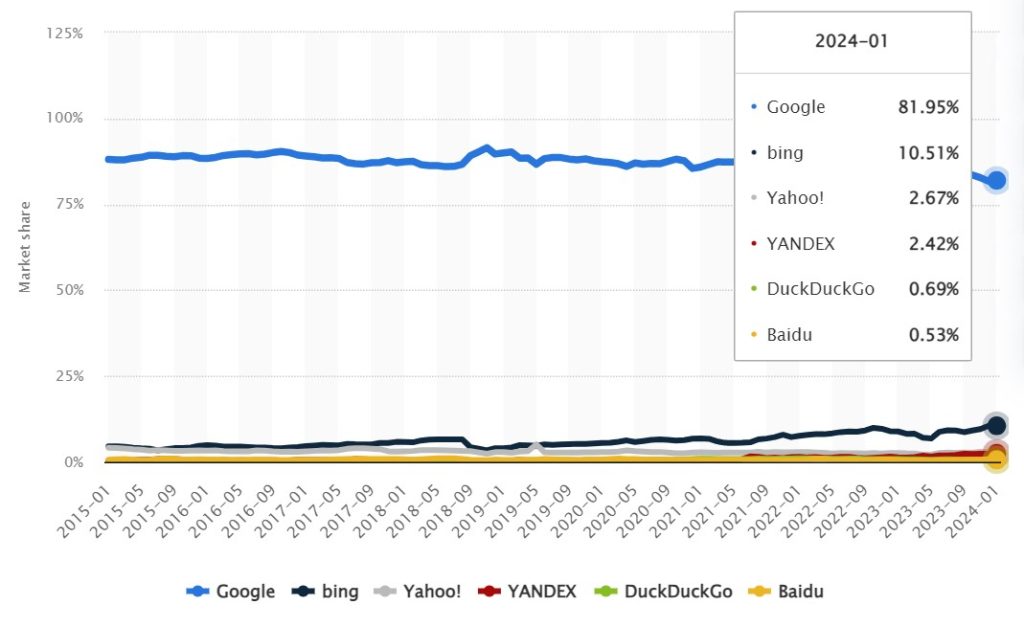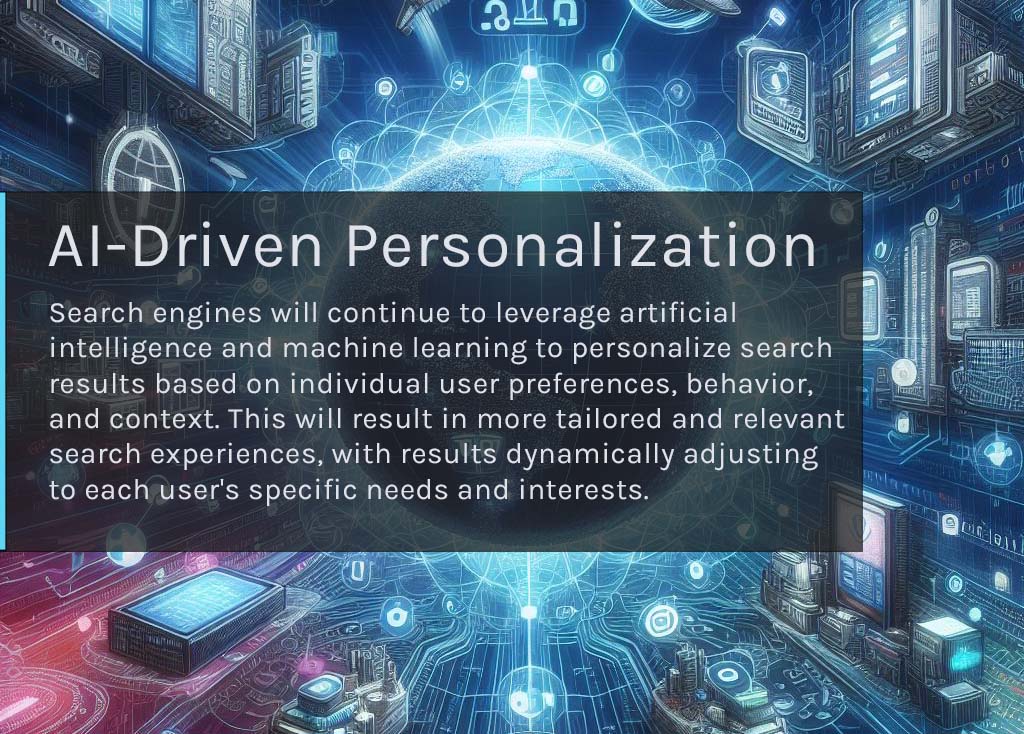Search engine evolution is a world full of drastic events that have an impact on most internet users, website owners, businesses, and accessible information. Search has become an integral part of our everyday life, at least every Internet user searches for something at least once a day, and they don’t even think about what machines and algorithms work under the search engine and how the relevant results are provided to the user.
However, after some time, when I already had a certain idea about the structure of the Internet, I also began to be interested in the principle of work of search engines, which was perhaps a great incentive for me to navigate myself in my professional career. And now, 22 years later, after exploring various corners of the Internet and testing the ups and downs of search engines hundreds of times, after experiencing dozens of major changes in web search and the workflows and effects of various search engine algorithms and SERPs, I reflect on the influence and evolution of search engines as a sub-industry as a specialist with long experience.

the first well-documented web search engine widely considered as the first was W3Catalog, developed by Oscar Nierstrasz and released in 1994. Concept of World Wide Web – Global Network. Image generated by AI.
Here it would be appropriate to ask the reader, when was the first time you interacted with the input field of a search engine and how did you feel when you found the information you needed on the computer screen? I guess Gen Z people will not have the exact answer and emotional feedback to this question, but the older generation might have nostalgic feelings remembering the times when they searched on Yahoo! or AOL websites, yes? 🙂
This is the story of how it all began – a bit nostalgic, a bit mixed with emotional elements — a journey through the corridors of the virtual world, where pioneers and enthusiasts embarked on a quest to organize the chaos of digital information and make the world’s data accessible to all internet users with just a few keystrokes.
This story was made with assistance from artificial intelligence, using Google Search, data sourced from statistical references, and my own memory 🙂
Search Engines: How it was began
When the first search engine was created and what was the name of the engine?
The first search engine is widely considered to be “Archie,” which was created in 1990 by Alan Emtage, a student at McGill University in Montreal, Canada. Archie was designed to index FTP (File Transfer Protocol) sites, allowing users to search for specific files. While Archie was not a traditional web search engine like the ones we use today, it laid the groundwork for later search engines by demonstrating the concept of indexing and searching for information on the internet.
Following the development of Archie, the first web search engine emerged in 1993. It was called “W3Catalog,” created by Oscar Nierstrasz at the University of Geneva. W3Catalog indexed titles of files in public FTP (File Transfer Protocol) archives. However, it was not until 1994 that the first search engine specifically designed for indexing and searching web pages became available. This search engine was called “WebCrawler,” created by Brian Pinkerton at the University of Washington. WebCrawler allowed users to search for information contained within web pages by entering keywords, marking a significant milestone in the evolution of search technology.
The appearance of Spiders and the era of Web crawlers

Web crawler indexing web pages on the internet. Image generated by AI.
During the phase of Crawler-Based Search Engines (1996-1999), there were significant advancements in web search technology and search engine evolution. Here are five key facts about this period:
-
Introduction of Web Crawlers
Web crawlers, also known as spiders or bots, were developed to systematically browse the web and index web pages. These crawlers followed hyperlinks from one page to another, collecting information about the content of each page and storing it in a searchable index.
-
Expansion of Search Engine Competitors
The mid to late 1990s saw a proliferation of search engine competitors, each attempting to improve upon the capabilities of existing search technologies. Companies like AltaVista, WebCrawler, Excite, and Lycos were some of the prominent players during this period.
-
Keyword-Based Indexing
Search engines primarily relied on keyword-based indexing to organize and retrieve web pages. Users entered keywords or phrases into the search engine interface, and the engine returned a list of relevant pages based on those keywords.
-
Limited Sophistication in Ranking Algorithms
Ranking algorithms during this period were relatively basic compared to later developments. Search results were typically ranked based on factors such as keyword density, meta tags, and the frequency of keyword occurrence within a page.
-
Emergence of Meta Search Engines
Meta search engines like Dogpile and MetaCrawler gained popularity during this period. Instead of maintaining their own indexes, these search engines aggregated results from multiple other search engines, providing users with a broader range of search results.
Overall, the era of Crawler-Based Search Engines laid the foundation for modern web search technology by introducing the concept of web crawling, indexing, and keyword-based retrieval. While these early search engines lacked the sophistication and relevance of contemporary search engines, they played a crucial role in shaping the landscape of information retrieval on the Internet.
Factors of keywords in search engines workflow

Google’s search algorithm considers not just the presence of keywords, but also their absence.
This means that if a page is missing certain keywords that would be expected for a particular topic, it could actually be penalized by the algorithm. This is because the absence of relevant keywords can indicate that the content is not comprehensive or relevant to the search query. Image generated by AI.
In the late 1990s, search engines transitioned from simply finding web pages containing keywords to ranking them based on relevance. This shift marked a crucial step towards providing users with more accurate and valuable search results. Here are five key facts about this era of search engine evolution:
- Early ranking algorithms: Initially, search engines relied heavily on keyword density, meaning the number of times a keyword appeared on a webpage. The more times a keyword appeared, the higher the page ranked.
- Limitations of keyword density: This approach had limitations. Websites could stuff keywords into their content (often in irrelevant ways) to manipulate their ranking, leading to poor user experiences.
- Beyond keywords: Search engines gradually started considering additional factors beyond keyword density. These included the location of keywords on the page (e.g., titles, headings), the presence of relevant synonyms, and the overall quality of the content.
- Link analysis: This period also saw the introduction of link analysis, a technique pioneered by Google. By analyzing the number and quality of other websites linking to a specific page, search engines could gauge its authority and relevance to a particular topic.
- Birth of complex algorithms: This era laid the foundation for the development of more complex and sophisticated ranking algorithms used by search engines today. These algorithms consider a vast number of factors, including user behavior, search intent, and the overall quality and user experience of a website.
By moving beyond simple keyword matching and incorporating various ranking factors, search engines were able to provide users with a more relevant and optimized search experience.
The era of web directories in the late 1990s and early 2000s

Web directory conceptual illustration by AI.
When I first searched on a computer, that was in the distant past, at the beginning of the 2000s, I had no idea where the search engine got and showed its information. In the early 2000s, web catalogs and website directories played a significant role in the online search landscape, often acting as supplementary resources for classic search engines.
These directories, like the highly-regarded Open Directory Project (ODP – DMOZ Directory), maintained curated lists of websites, categorized by topic. Being listed in such directories, particularly the ODP (hosted on dmoz.org), could potentially improve a website’s ranking in search results from engines like Google, as these directories were considered a mark of quality and relevance.

Famous DMOZ.org – Open Directory Project. Image from webdesignmuseum.org
The famous web directory Dmoz.org, which hosted the Open Directory Project (ODP), officially closed its doors on March 17, 2017. The reasons for its closure were disclosed as:
- Declining usage: With the rise of more sophisticated and automated search engine algorithms, the curated approach of ODP became less relevant for users seeking information online.
- Maintenance challenges: Maintaining a vast directory of websites, especially with the ever-changing nature of the internet, proved increasingly difficult and resource-intensive.
- Shifting priorities: The organization behind ODP, the Mozilla Foundation, decided to focus its resources on other projects aligned with their core mission, such as promoting open web standards and user privacy.
While the ODP may have shut down, its legacy lives on through the impact it had on shaping the early internet landscape and its contribution to the development of search engine technology.
The era of Yahoo!

Search Engine Evolution. Image by AI.
What was the famous search engine in the 1990s
In the 1990s, one of the most famous and influential search engines was “Yahoo!” Yahoo! was founded in 1994 by Jerry Yang and David Filo, who initially started it as a directory of websites called “Jerry and David’s Guide to the World Wide Web.” However, as the internet grew rapidly, Yahoo! evolved into a full-fledged search engine, providing users with the ability to search for websites, news articles, images, and more. Yahoo! quickly became one of the most popular destinations on the web during the 1990s and early 2000s, serving as a gateway to the vast array of content available online.
Yahoo’s key point as a search engine was its comprehensive directory of websites. Unlike traditional search engines that relied solely on algorithms to index and rank web pages, Yahoo! initially employed a team of human editors to categorize and organize websites into a hierarchical directory. This directory structure made it easier for users to navigate the web by browsing through different categories and subcategories to find relevant information.
Yahoo’s directory approach was particularly valuable in the early days of the Internet when the amount of online content was relatively limited compared to today. Users could explore various topics and discover new websites by browsing through Yahoo’s curated lists of websites.
Additionally, Yahoo! offered other features such as email, news, and messaging services, which helped to solidify its position as a leading internet portal during the 1990s. Overall, Yahoo’s key point as a search engine in the 1990s was its user-friendly directory interface and its role as a comprehensive gateway to the web.
After Yahoo!…
After Yahoo’s era as a dominant search engine, several significant developments reshaped the landscape of online search:
Emergence of Google
In the late 1990s and early 2000s, Google emerged as a formidable competitor to Yahoo with its superior search algorithms and focus on relevance and user experience. Google’s PageRank algorithm revolutionized search by prioritizing pages based on their quality and relevance, rather than just keyword density or metadata.
Rise of Google as the dominant player
Google’s relentless focus on innovation and its ability to deliver highly relevant search results quickly propelled it to the top of the search engine market. By the mid-2000s, Google had surpassed Yahoo as the most popular search engine worldwide and became synonymous with internet search.
Yahoo’s decline
Despite its early success, Yahoo struggled to keep pace with Google’s innovations in search technology. Yahoo faced internal challenges, management changes, and strategic missteps that led to a decline in its search market share and overall relevance in the industry.
Diversification of search
Alongside Google, other search engines like Bing (launched by Microsoft) emerged as competitors in the search market. Additionally, the rise of vertical search engines focusing on specific niches, such as e-commerce (e.g., Amazon) or travel search engines (e.g., Kayak), provided users with more specialized search experiences.
Shift to mobile and voice search
The proliferation of smartphones and the advent of voice-activated virtual assistants (e.g., Siri, Alexa, Google Assistant) led to a shift in how people search for information. Mobile search and voice search became increasingly important, prompting search engines to adapt their algorithms and interfaces to accommodate these trends.
Google’s era in the search market
I have highlighted some important key points that contributed to Google’s ascent to becoming the world’s leading search engine in the 2000s:
Superior search algorithms and user-friendly technologies
Google’s PageRank algorithm, developed by Larry Page and Sergey Brin, revolutionized search by prioritizing web pages based on their relevance and quality. This algorithm helped Google deliver more accurate and useful search results compared to its competitors.
Here are the key factors about PageRank created by Google:
- Link-based algorithm: PageRank is a link-based algorithm that evaluates the importance of web pages based on the quantity and quality of links pointing to them. In essence, it views links as votes of confidence: the more links a page receives from other reputable pages, the higher its PageRank score.
- Importance of backlinks: PageRank considers both the number of backlinks (links from other websites to a particular page) and the authority of the linking pages. Links from high-authority websites are given more weight and contribute more to the PageRank score of the linked page.
- Iterative calculation: PageRank is calculated iteratively through a process of repeated computation. Initially, all web pages are assigned an equal PageRank score. In subsequent iterations, the PageRank of each page is updated based on the PageRank scores of the pages linking to it.
- Impact on search results: Pages with higher PageRank scores are considered more authoritative and are more likely to appear higher in Google’s search results for relevant queries. PageRank thus helps Google rank search results in order of relevance and importance, making it a fundamental component of Google’s search algorithm.
- Evolving role: While PageRank was a foundational algorithm for Google’s early success, Google has since incorporated numerous other factors into its search algorithm, and PageRank is no longer the sole determinant of search rankings. However, the principles of PageRank – such as the importance of backlinks and the concept of authority – continue to influence Google’s ranking algorithms to this day.
And yes, PageRank revolutionized search by introducing a sophisticated approach to ranking web pages based on their link profile, and in fact it remains one of the most influential algorithms in the history of search engines.
As for the user-focused approach, Google prioritized the user experience, aiming to provide fast, relevant, and reliable search results. Its simple and minimalist interface made it easy for users to find the information they needed quickly and efficiently.
Google’s continuous innovation was relentless in its pursuit of innovation, constantly refining its search algorithms and introducing new features to improve search quality and user experience. This commitment to innovation helped Google stay ahead of the competition and maintain its position as the leading search engine.
Expansion of services also impacted the growth of Google. Beyond search, Google diversified its offerings with a range of products and services, including Gmail, Google Maps, Google News, and Google My Business. These complementary services enhanced Google’s ecosystem and further solidified its dominance in the online space.
Strategic partnerships and acquisitions were also an additional incentive for Google to win the hearts of users and attract more traffic. Google strategically partnered with other companies and acquired innovative startups to enhance its search capabilities and expand its reach. For example, partnerships with Mozilla and AOL helped Google reach a broader audience, while acquisitions like YouTube and Android provided new avenues for growth and innovation.
Innovations and refinements in search algorithms
The era known as the “Age of Search Refinements,” spanning from the 2000s to the 2010s, witnessed notable strides in search engine technology, emphasizing personalization, enhanced user experience, and a broader array of search functionalities beyond conventional keyword-based queries. Here’s a deeper exploration of this period:
Key characteristics and advancements
- Personalized Search: Search results underwent personalization based on variables such as user location, search history, and browsing habits, aiming to furnish more pertinent and contextually fitting outcomes.
- Expansion Beyond Text Search: Search engines broadened their scope beyond textual content, introducing features like image search (e.g., Google Images) and video search (e.g., YouTube), enabling users to access information through diverse media formats.
- Introduction of Advanced Search Options: Enhanced search options emerged, allowing users to refine results based on parameters like date, language, domain, and other criteria, thereby facilitating a more refined and tailored search experience.
- Emphasis on User Experience: Search engine interfaces underwent improvements to enhance user-friendliness and visual appeal, incorporating features like auto-complete suggestions, spell check, and snippets of pertinent information directly within the search results page (SERP).
- Rise of Specialized Search Verticals: Specialized search engines catering to specific domains such as travel, shopping, and news (e.g., Kayak, Amazon, Google News) gained traction, offering users a more focused and streamlined search experience within their respective niches.
Impact on search behavior
- Increased User Engagement: These refinements led to extended user engagement on search engines, as users encountered more relevant results and explored diverse search options.
- Evolution of Search Queries: With search engines becoming more sophisticated, users began formulating intricate and specific search queries, expecting precise and nuanced information in return.
- Emphasis on Content Quality: Websites featuring high-quality content, intuitive design, and optimization for relevant search terms began to ascend in search rankings, prompting shifts in website development and content creation strategies.
Overall, the Age of search refinements profoundly transformed user interactions with search engines, laying the groundwork for the development of even more advanced and intelligent search technologies in the years to come.
Impact of mobile devices on search: Rise of the Mobile search

The rise of mobile search, driven by the widespread adoption of smartphones and other mobile devices, has significantly impacted the way people access information online. Here are five key facts about the impact of mobile devices on search:
-
Proliferation of Mobile Devices
The widespread adoption of smartphones and tablets has led to a significant increase in mobile internet usage. With the convenience of accessing the internet on-the-go, more people are turning to their mobile devices to perform searches, surpassing traditional desktop searches in many regions.
-
Mobile-First Indexing
Search engines like Google have implemented mobile-first indexing, prioritizing the mobile version of websites for indexing and ranking. This shift acknowledges the importance of mobile-friendly web design and ensures that mobile-optimized content receives better visibility in search results.
-
Localization and Contextual Relevance
Mobile devices often have location services enabled, allowing search engines to deliver more contextually relevant results based on the user’s location. This localization aspect is particularly significant for searches related to local businesses, services, or events, as users frequently seek nearby options while on the move.
-
Voice Search and Virtual Assistants:
The rise of voice-enabled virtual assistants, such as Siri, Google Assistant, and Amazon Alexa, has facilitated the growth of voice search on mobile devices. Users can now perform searches using natural language commands, leading to changes in search query patterns and the need for search engines to understand conversational queries.
-
Micro-Moments and Instant Answers
Mobile search has given rise to micro-moments, where users turn to their devices for quick, on-the-spot information to fulfill immediate needs. Search engines respond to this trend by prioritizing instant answers, featured snippets, and knowledge cards in search results, providing concise and relevant information directly on the search engine results page (SERP).
Overall, the rise of mobile search has reshaped the search landscape, emphasizing the importance of mobile-friendly web design, local optimization, voice search optimization, and providing quick, relevant information tailored to users’ on-the-go needs. As mobile usage continues to grow, search engines will continue to adapt to meet the evolving preferences and behaviors of mobile users.
Social media’s role in the search industry
The concept of Social Search emerged in the 2000s with the rise of social media platforms and the growing influence of user-generated content (UGC) on online information consumption. Here are five key facts about this ongoing development:
-
Integration of social signals
Search engines began to incorporate social signals into their ranking algorithms. This includes factors like shares, likes, and mentions on social media platforms, reflecting the perceived value and relevance of content based on user interaction.
-
Rise of user reviews and opinions
The influence of user reviews, ratings, and recommendations on social media and other online platforms started playing a larger role in search results. This allows users to see the “social validation” of content beyond traditional factors like keyword presence.
-
Personalized search based on social connections
Search engines started to personalize search results based on users’ social connections. This means that content shared or endorsed by friends and contacts on social media platforms could be prioritized in search results.
-
Real-time search and trending topics
Social media facilitated real-time search and trending topics. Search engines began to display results and information dynamically based on what’s currently being discussed and shared on social media, offering users a glimpse into current events and popular conversations.
-
Evolving search behavior
The rise of social search encourages users to combine social media interaction with traditional search practices. This can involve searching for information on specific topics within social media platforms or using social recommendations to find relevant content across the web.
The impact of social search on the search market
While social search enhances search relevance and reflects user preferences, it also raises concerns about potential biases and echo chambers. Algorithms that prioritize content based on social media activity could inadvertently amplify certain viewpoints and limit exposure to diverse perspectives. Therefore, it’s crucial to maintain a critical approach to information encountered through social search and actively seek out diverse viewpoints.
Semantic search
The rise of semantic search in the 2010s marked a significant shift in search engine technology, focusing on understanding the intent and context behind user queries rather than relying solely on matching keywords. Semantic search aimed to deliver more accurate, relevant, and contextually appropriate search results by comprehending the meaning of words, phrases, and their relationships within a query. Here are five key points about semantic search:
-
Understanding Context and Intent
Semantic search algorithms analyze the context of a user’s query by considering factors such as user location, search history, previous interactions, and natural language patterns. By understanding the intent behind a query, search engines can deliver more relevant results even if the exact keywords are not present.
-
Entity-Based Search
Semantic search focuses on identifying entities (people, places, organizations, concepts, etc.) within a query and understanding their relationships. Search engines use knowledge graphs and structured data to organize information about entities and their attributes, enabling more accurate interpretation of user queries and content relevance.
-
Natural Language Processing (NLP) and Machine Learning
Semantic search relies on advanced natural language processing (NLP) techniques and machine learning algorithms to analyze and understand the meaning of words and phrases in context. These technologies enable search engines to interpret complex queries, understand synonyms, detect sentiment, and infer user intent with greater accuracy over time.
-
Richer Search Results
Semantic search enables search engines to provide richer and more diverse search results beyond traditional blue links. This includes featured snippets, knowledge panels, direct answers, related questions, and other types of structured data displayed directly on the search engine results page (SERP), enhancing the user experience and providing quick access to relevant information.
-
User-Centric Approach
Semantic search aligns with the user-centric approach to search, prioritizing user satisfaction by delivering highly relevant and contextually appropriate results. By understanding the semantics of a query, search engines aim to anticipate user needs, provide personalized recommendations, and facilitate more meaningful interactions between users and information.
The rise of semantic search in the 2010s revolutionized the way search engines interpret and respond to user queries, moving towards a more intelligent, intuitive, and user-centric approach to information retrieval on the web. As semantic search continues to evolve, it will further refine search engine capabilities and enhance the overall search experience for users worldwide.
Knowledge graphs
Knowledge graphs are essentially semantic networks that represent real-world entities and the relationships between them. They use a graph structure, where nodes represent entities (such as people, places, things, or concepts) and edges represent the connections between these entities (e.g., “is a part of,” “located in,” “created by”).
Key components of knowledge graphs:
- Nodes: Represent individual entities.
- Edges: Define the relationships between entities.
- Labels: Provide additional information about both nodes and edges, adding context and meaning.
How are Knowledge Graphs impacted search engine evolution?
Knowledge graphs are used in various applications, including:
- Semantic search: Enabling search engines to understand the meaning and context of search queries, leading to more accurate and relevant results.
- Personalization: Tailoring user experiences based on their interests and preferences by understanding their interactions with different entities within the knowledge graph.
- Recommendation systems: Recommending relevant products, services, or information based on a user’s past behavior and connections within the knowledge graph.
- Fraud detection: Identifying suspicious patterns by analyzing relationships between entities in the knowledge graph.
Benefits:
- Improved understanding of data: Knowledge graphs provide a richer and more interconnected view of information, making it easier to understand the relationships between different entities.
- Enhanced user experiences: They allow for more context-aware applications and services, leading to better user satisfaction and engagement.
- Enabling AI applications: Knowledge graphs play a crucial role in powering various AI applications that require understanding the real world and its connections.
Overall, knowledge graphs are powerful tools for organizing and representing information in a way that is both human-readable and machine-interpretable, leading to advancements in various fields and applications.
The age of AI-powered search: nowadays search engines
The current era of search is characterized by the integration of artificial intelligence (AI) technologies into search engine algorithms. This brings significant advancements in search functionalities and capabilities, aiming to deliver a more intuitive and personalized search experience for users. Here’s a deeper look into this ongoing development:
Key features and advancements:
- Natural Language Processing (NLP): AI-powered search utilizes NLP techniques to understand the intent and context behind search queries, enabling search engines to move beyond keyword matching and interpret the meaning of user input more accurately.
- Voice Search: The rise of voice assistants like Siri, Alexa, and Google Assistant has led to the widespread adoption of voice search. AI enables search engines to understand and respond to spoken language, making search more natural and convenient.
- Answering Complex Questions: Search engines are evolving towards answering complex questions directly instead of simply providing a list of links. AI allows them to analyze the intent and context of a query, retrieve relevant information from various sources, and synthesize it into a concise and informative answer.
- Visual Search and Image Recognition: AI-powered visual search capabilities enable users to search for information using images rather than text. Image recognition algorithms analyze visual content and identify objects, landmarks, products, and text within images, facilitating visual search experiences on platforms like Google Images and Pinterest.
- Personalized Search Refinement: AI can further personalize search results based on a user’s individual preferences, search history, and real-time context. This allows for a more tailored search experience that anticipates user needs and delivers highly relevant information.
- Predictive Search and Suggestions: AI enables search engines to predict user intent and suggest potential search queries as users type, offering a more interactive and efficient search experience.
Impact and potential of AI-powered search
- Improved User Experience: AI has the potential to make search more intuitive, natural, and user-friendly, bridging the gap between how people think and how search engines work.
- Enhanced Information Access: AI can enable users to access and understand information in various formats, including text, images, and videos, through multilingual and multimodal search capabilities.
- Evolving Search Landscape: As AI continues to evolve, we can expect further advancements in search functionalities such as personalized learning, real-time information retrieval, and even proactive search experiences that anticipate user needs before they arise.
Challenges and considerations
While AI offers significant potential for search advancements, it also presents certain challenges:
- Bias and Fairness: Ensuring that AI algorithms are free from biases and promote fair representation is crucial to avoid perpetuating discriminatory or misinformation practices.
- Transparency and Explainability: It’s important to maintain transparency in how AI algorithms function and why specific search results are presented to users. This fosters user trust and allows for informed decision-making.
- Ethical Considerations: The development and application of AI-powered search must adhere to ethical considerations, ensuring respect for privacy, data security, and responsible information dissemination.
To summarize, the Age of AI-Powered Search represents an exciting and dynamic stage in search engine evolution. By leveraging AI responsibly, we can unlock its potential to enhance information access, and user experience, and empower individuals to navigate the ever-growing realm of online information more effectively.
Google’s global reach
It won’t be a secret if I say with confidence that 90% of the readers of this article have searched for something on Google today, specifically about search engines. That’s why you’re reading this article right now.
Google expanded its presence internationally, offering search services in multiple languages and tailoring its algorithms to accommodate different regions and cultures. This global reach helped Google become the go-to search engine for users around the world.
Google’s global reach is truly extensive, characterized by several key points:
- Market Share: Google holds a staggering over 80% market share of global desktop search traffic and nearly 90% of mobile search traffic [Statista]. This means that billions of people around the world use Google as their primary tool for finding information online.

Global Search Market Share by 2024 January. Screenshot from Statista.
- Beyond Search: Google offers a wide range of products and services beyond search, including Gmail, YouTube, Android, Google Maps, and Google Translate. These are used by billions of users globally, further solidifying their digital presence.
- Multilingual Support: Google is available in over 100 languages, catering to diverse user bases worldwide. Additionally, their products and services are adapted to local contexts and cultural nuances.
- Global Infrastructure: Google maintains a vast network of data centers and servers spread across the globe. This ensures fast and reliable access to their services for users in different locations.
- Free Services: Many of Google’s core services are offered free of charge, making them accessible to a wider audience, even in regions with limited resources.
- Information Access: Google plays a crucial role in enabling global access to information, and connecting people across borders and cultures.
- Digital Ecosystem: Google’s global reach contributes significantly to the development and growth of the digital ecosystem, impacting various aspects of online communication, commerce, and information dissemination.
Overall, Google’s combination of superior technology, user-centric approach, continuous innovation, diversified offerings, strategic partnerships, and global reach were key factors that propelled it to the forefront of the search engine industry in the 2000s.
Future of search

AI-Drive personalization on search engines (future forecast and trends). Image generated by AI.
I’m sure many people are thinking about the technological possibilities of the future and the innovations to come, but who can say for sure what the future holds? If you are not from the future, it is a difficult task to see the future. However, with all this, following the current trends of media, technology, and artificial intelligence and taking into account the developments of technical possibilities, we can roughly imagine the direction in which the developments of search systems can go.
The AI-driven search engines from Google, known as Gemini, and Microsoft, called CoPilot, along with the forthcoming search engine from OpenAI, are poised to bring about remarkable transformations beyond our current imagination.
Let’s see what Google’s Gemini says about the possible future of search engines:
- AI-Driven Personalization: Search engines will continue to leverage artificial intelligence and machine learning to personalize search results based on individual user preferences, behavior, and context. This will result in more tailored and relevant search experiences, with results dynamically adjusting to each user’s specific needs and interests.
- Voice and Conversational Search: The adoption of voice-enabled devices and virtual assistants will continue to grow, leading to an increase in voice and conversational search. Users will interact with search engines using natural language commands, and search results will be delivered through spoken responses, transforming the way people access information.
- Visual Search: Visual search technologies will become more sophisticated, allowing users to search for information using images or videos rather than text. Image recognition and augmented reality (AR) will enable users to identify objects, products, landmarks, and other visual elements in real-time, providing a seamless visual search experience.
- Augmented Reality (AR) integration: AR integration in search could allow users to visually interact with search results and explore information in an immersive and interactive way.
- Contextual Understanding: Search engines will develop a deeper understanding of user intent and context, considering factors such as location, time, device, and previous interactions. This contextual understanding will enable more precise and relevant search results, anticipating user needs and delivering information proactively.
- Integration with Emerging Technologies: Search will increasingly integrate with emerging technologies such as blockchain, decentralized finance (DeFi), the Internet of Things (IoT), and augmented reality (AR). This integration will enable new search experiences, such as searching for IoT devices, accessing decentralized information sources, and overlaying search results onto the physical world through AR.
- Augmented Intelligence: Search engines will evolve from providing mere information retrieval to offering augmented intelligence capabilities, assisting users in decision-making, problem-solving, and knowledge discovery. Advanced analytics, natural language understanding, and predictive modeling will empower users to extract insights and derive actionable intelligence from search results.
- Ethical and Privacy Considerations: As search technologies become more powerful and pervasive, there will be an increased emphasis on ethical use, transparency, and user privacy. Search engines will need to balance the benefits of personalized experiences with the protection of user data and privacy rights, leading to the development of privacy-preserving search algorithms and enhanced user control over personal data.
Ethical considerations to include:
- Combating bias and misinformation: Addressing and mitigating biases and misinformation within search algorithms will be crucial to ensure fair representation and trustworthy information access.
- Ethical AI development: The development and application of AI-powered search will require careful ethical considerations to avoid unintended consequences and promote responsible information dissemination.
In my opinion, the future of search promises increasingly intelligent, personalized, and immersive experiences, driven by advancements in artificial intelligence, natural language processing, visual recognition, and the integration of emerging technologies. While the specifics may vary, the overarching goal will be to empower users with seamless access to information, insights, and assistance in navigating the complexities of the digital world.

